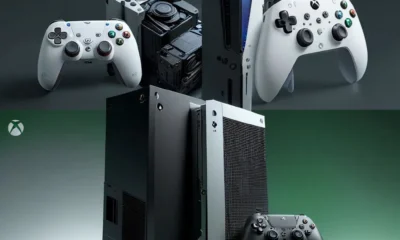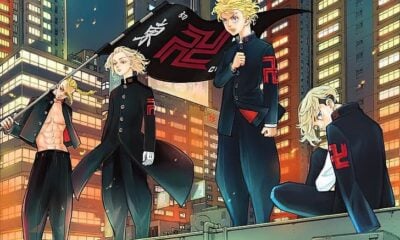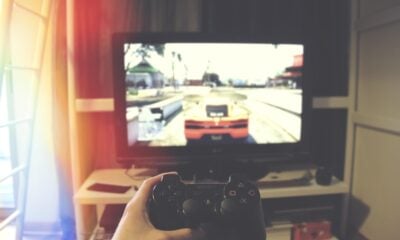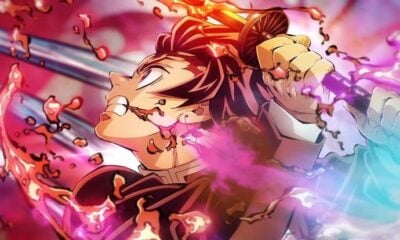Features
The Art of Combat in ‘Ocarina of Time’

Ocarina of Time is often compared directly to A Link to the Past when discussing The Legend of Zelda. Both titles feature near-identical pacing, a story broken down in roughly the exact same structure, and more than a few shared gameplay beats. It’s no stretch to say A Link to the Past set the foundation for Ocarina of Time to seamlessly transition the franchise into 3D, so it’s not a shock the discourse surrounding both games goes hand in hand. As easy as it is to draw comparisons to A Link to the Past, however, Ocarina of Time owes most of its identity to the franchise’s black sheep: The Adventure of Link. While exploratory by design, Zelda II’s main focus was fast, skill-based combat on a 2D plane. It was a fundamentally different experience than its predecessor, but one that was still recognizably Zelda.
Although Zelda II’s reception tends to be tepid with fans of the franchise, the same can’t be said for the series’ actual staff. Series creator Shigeru Miyamoto has expressed his relative disappointment with the franchise’s sophomore title in the past, but it’s evident he holds the RPG in high esteem. The Adventure of Link was a change of pace for Zelda, but a necessary one for the series’ progression. Zelda II experimented with an action on a level the original couldn’t, yet it still left something to be desired between the limitations of the NES and the title’s own design flaws. A Link to the Past would refine several of AoL’s conventions into its own core design, albeit stylized around the original Legend of Zelda. With no true successor and a source game that didn’t live up to its full potential, Miyamoto was evidently unsatisfied leaving Zelda II as is.
Working alongside Ocarina of Time’s eventual 3D System Director, Shigeru Miyamoto and Yoshiaki Koizumi briefly started remaking Zelda II: The Adventure of Link for the Super Famicom. In an Iwata Asks pertaining to Ocarina of Time 3D’s development, Satoru Iwata references chanbara swash-buckling– a style of methodical sword fighting seen in samurai cinema– as a direct influence for Ocarina’s combat;
“When people talk about The Legend of Zelda: Ocarina of Time, they mention various things like an epic story, solving puzzles, trotting across a broad field on a horse and how cool Link is, but it began with the single theme of making a Zelda game that included chanbara-style swashbuckling!”
Koizumi later clarifies, however, that chanbara had been the influence for remaking Zelda II all those years prior; “We couldn’t really bring Zelda II: The Adventure of Link into form at that time, but I kept that desire to achieve a sword-fighting Zelda game until I joined this team.” Naturally, any form of realistic combat in a video game would require a three-dimensional space. The SNES may have been capable of rendering three-dimensional polygons, but the hardware could only emulate 3D so far.
Miyamoto and Koizumi would leave their aspirations for an Adventure of Link remake behind as development began on the first 3D Zelda for the Nintendo 64, but their work wasn’t for naught. Had the two not tinkered with remaking Zelda II leading into the N64’s heyday, it’s unlikely Ocarina of Time would have found its combative voice. In fact, OoT’s early design resembled AoL more than it did A Link to the Past by featuring screen switching. One of Zelda II’s defining aspects is the fact that Hyrule is explored from an overhead view like in The Hyrule Fantasy while the combat takes place within “action screens” in the same vein as the action side-scrollers of the era.
Miyamoto’s original vision for Ocarina featured Link exploring Ganon’s Castle in first-person, with battles transitioning to & fought from a ‘side perspective’ where Link’s character model could be seen. Such a radical departure for the franchise was reined into fully third-person gameplay that was recognizably Zelda, but transitioning Link’s swordplay into 3D naturally brought obstacles. How do you control the flow of combat in a 3D space? There are only so many ways an enemy can move, attack, or interact with the player in 2D. Even when there were multiple enemies on-screen in previous Zelda games, they were easy to handle because they weren’t always perceptive to Link; and if they were, it was only within their set walking patterns.
In a 3D space meant to evoke some semblance of reality through gameplay, enemies can’t just stand aside & ignore Link while he’s running around a fully rendered world with spatial depth. Enemies shouldn’t just gang up on the player either, as such aggression would arguably be more alienating than Zelda II’s base difficulty. It’s important to remember that Ocarina of Time was codifying gameplay not just for Zelda, but the medium. For The Legend of Zelda– and subsequently gaming– to successfully make the shift into 3D, Nintendo would need to look beyond the scope of video games.
Ocarina of Time’s director & writer, Toru Osawa, suggested the development team visit Toei Kyoto Studio Park, an Edo period-inspired theme park where the staff could potentially find chanbara-fueled inspiration. The idea for Z-Targeting (Ocarina of Time’s lock-on system) came about when Yoshiaki Koizumi watched a sword fight and noticed how the hero performer could defeat nearly 20 enemies despite being both surrounded & outnumbered.
“It’s a sword battle, so there’s a script and a certain setup. The enemies don’t all attack at once. First, one attacks while the others wait. When the first guy goes down, the next one steps in, and so on.”
As Koizumi puts it, “Z-targeting flags one particular opponent, telling the other enemies to wait.” The moment an enemy is defeated, Z-targeting can immediately lock onto a new opponent, keeping the flow of combat steady. Z-targeting was conveyed with a Fairy marker in-game for the sake of spatial awareness, affectionately nicknamed the Fairy Navigation System by Koizumi. Navi can be seen from a distance no matter what, making it easy to parse key visual information– like which enemy to focus on. Z-targeting began to infer Ocarina of Time’ design at this point, from the story now framing itself around Link’s relationship with his fairy to the overall gameplay.
Z-targeting’s convenience goes beyond combat, doubling as a camera. By clicking Z, players can reorient Link’s vision. The camera will snap wherever he’s facing, making it easy to always see what’s in front of you. Level geography and field of view are even designed around click positioning, with Navi outright suggesting players do so at certain set pieces (most notably the maze in the Lost Woods.) Ocarina of Time was originally going to feature a jump button in another tie to Zelda II, but auto-jumping as a replacement is an elegant workaround that works with Z-targeting instead of against. Link being able to jump at a moment’s notice would complicate combat & dungeon crawling. Auto-jumping keeps both gameplay and game design grounded, a necessity for video game chanbara.
Ocarina of Time’s combat rhythm is one that requires diligence, patience, and an eye for telegraphs. These are back & forth battles where you’re expected to bide your time– wait for openings, not force them. The letterbox frame that’s paired with Z-targeting does an excellent job of indicating that action is something to be respected. It’s not a screen switch, but it’s a fundamental shifting of perspective that’s evocative of Zelda II. Swordplay almost exists in its own world. You still need to be mindful of your surroundings, of course, but Z-targeting makes it easy to digest OoT’s combat.
To the game’s credit, combat does work relatively well without Z-targeting and there are even early enemies that Link can easily defeat without a lock-on. That said, it’s hard to ignore just how fluid Z-targeting makes swordplay. Link’s actions are noticeably faster when he’s locked on, and there are even slight differences to his attacks in & out of Z-targeting.
Link has access to full sword combos for the first time in the series. He’ll default to three horizontal slashes in normal gameplay and three vertical when locked on, but directional inputs can influence how he attacks. By pressing forward without locking on, Link can combo verticality. Similarly, Link will launch into a series of horizontal slashes by pulling back on the analog while Z-targeting. Pushing forward will launch Link into a stab-based combo, pressing A while locked on will trigger a jumping slash, and rotating the analog before attacking activates Link’s spin attack without any windup. Mechanically, Ocarina of Time is the most in-depth of the first five games.
While Link can’t jump, the A button gives players access to dodging. Rolling out of danger is always an option, but Z-targeting changes up Link’s action button on the fly. Link will still roll if you hold forward on the analog, but pulling back will trigger a backflip & holding left or right will cause him to sidestep. The variety is fun to play around with, but dodging isn’t actually called upon enough by the game design. Only a few enemies force Link to quickly move out of the way, to begin with and blocking is arguably too useful to make dodging appealing.
Link’s shield can block most attacks, triggered with button inputs like in Link’s Awakening. Unlike Link’s Awakening, Ocarina of Time’s shield has its own dedicated button so that it can remain a constant part of Link’s tool kit. In practice, blocking trivializes combat more often than not, making it too easy to play things safe. There are attempts at countering the shield’s usability, but Nintendo frankly goes easy on players. The Deku Shield can be burned away, but fire is only a real threat inside of Dodongo’s Cavern and the Spirit Temple. The Hylian Shield can be eaten by Like-Likes, but they don’t appear often enough to be a genuine risk (it’s also very easy to reclaim an eaten shield.)
If nothing else, Ocarina of Time does at least acknowledge this oversight. Beginning with the Spirit Temple, players will start encountering Iron Knuckles– mini-bosses whose attacks connect through Link’s shields. Trying to block an Iron Knuckle‘s ax will simply result in flying backwards as he loses four Hearts (out of a max 20.) Iron Knuckles actually force you to backflip or sidestep out of the way depending on which direction their swings are coming from. They’re some of the best-designed enemies in the game, & not just because they remove the player’s crutch. Iron Knuckles are always fought in destructible environments (prep for the final fight against Ganon;) they have a second phase where their speed increases; and Link can keep Iron Knuckles stunned with his combos once they lose their armor, rewarding aggressive play for a change.
Ocarina of Time’s difficulty curve is too easy for too long, but it does gradually pick up with time– which speaks to the game’s greatest strength: pacing. Unlike Zelda II which threw players into the deep end right away, Ocarina of Time paces its gameplay very carefully. Child Link’s half of the adventure is noticeably less dangerous, his most arduous foes the rare Lizalfos and Wolfos. The game is too generous with how much time it allows players to accustom themselves to the battle system in hindsight, but Ocarina of Time was the first 3D game of its kind. 3D gaming is the norm today– making it easy to return to Ocarina of Time & understand exactly how to navigate in its space– but this was not the case in 1998 and there is merit in Nintendo erring on the easier side. OoT’s curve not only ensures timelessness but vast accessibility.
Combat is easy to pick up, fun to master, and manages to pack in a lot of style & depth with plenty of variety. Link might not move in a first-person view, but there are FPS elements present through the Fairy Slingshot, Boomerang, Fairy Bow, and Hookshot. Z-targeting lets Link aim directly at a target in the third-person, but the first person view is useful for sniping enemies from afar or lining up precise shots. Aiming’s stiffness can be a bit difficult to get used to, but modern analogs hide OoT’s age in this regard. Aimable weapons working in third-person so long as you’re locked-on also helps in mitigating this problem.
Aside from first-person weapons, Ocarina of Time’s item set deserves praise for just how useful Link’s equipment is. Deku Nuts stun most enemies, Bombchus hone in on targets to blow them up, and Deku Sticks offer young Link a weapon stronger than his sword at the expense of breaking upon impact. Magic makes a comeback after being absent in Link’s Awakening, with Link having access to spells named after Hyrule’s three Golden Goddesses. Din’s Fire unleashes a burst of flame in the nearby vicinity, Nayru’s Love blocks any & all damage for a short period of time, and Farore’s Wind lets you create warp points within dungeons. Each spell has its own specific use, all useful in their own right. Players can even unlock the ferociously powerful Biggoron’s Sword as an adult if they crave a bigger blade.
For better or worse, Ocarina of Time sets the standard for dungeon weapons as boss weaknesses. On one hand, every item has a memorable combat purpose. On the other, a weapon like the Megaton Hammer really only works against its specific boss, Volvagia. In the worst cases, the dungeon weapons simply end up inferring boss design negatively. King Dodongo should be an imposing & tense fight, but he’ll slurp your bombs to death within seconds. Twinrova is a fun puzzle fight with plenty of spectacles, but there’s only so much the Mirror Shield can do mechanically. The second half of the battle amounts to little more than knowing when to let go of the R button or sidestep.
Thankfully, Ocarina’s many mini-bosses make consistently great use of combat. Beyond Iron Knuckles, the Water Temple’s fight against Dark Link is a solid contender for one of the best fights in the game. Not only can you cheese your way through the fight with Din’s Fire, the Megaton Hammer, or the Biggoron’s Sword, it’s immensely satisfying to treat the battle with Dark Link as a proper one on one deal. Dark Link demonstrates the full potential of OoT’s combat, reacting to directional inputs in order to counter your play style.
Dark Link’s aggression is punishing, but it’s not random. Stab forward and he’ll jump on your sword. Keep doing it and he’ll learn to cut you before he jumps off. Dark Link also parries Link’s strikes as he makes them, requiring you to know exactly how to control the Master Sword. It’s very much possible to cut through Dark Link’s guard, but you won’t do it if you’re haphazardly mashing B. Taking out Dark Link as intended means slowly reading his movements and attacking deliberately. Link’s fight against his shadow is arguably the best representation of chanbara in the game.
Ocarina of Time is at its most action-heavy in the Shadow Temple, one of two prospective final dungeons alongside the Spirit Temple. Where the Spirit Temple is puzzle centric, the Shadow Temple is combat heavy with a host of mini-bosses & uncommon enemies. Players even find the Hover Boots ASAP, a mobility-focused dungeon item you don’t have to so much as think about once they’re equipped. Not just that, the Shadow Temple’s other major puzzle tool is the Lens of Truth, a passive item that doesn’t hinder Link’s combat. As a result, the Shadow Temple revels in a level of violence no other dungeon does. Something that’s outright expressed through the bloodstained torture chambers that litter the Temple.
The Shadow Temple highlights the creativity of Ocarina of Time’s enemy design more so than any other dungeon. Deadhand is a grotesque monstrosity who hides under the battlefield and only comes up either to feed on Link once he’s been trapped, or after players blow up their hiding spot with a bomb. Stalfos now respawn upon death, turning the Forest Temple’s mini-bosses into a common enemy. Redeads & Gibdos paralyze Link with fear, forcing you to kill them as fast as humanly possible. Floormasters basically patrol the last chunk of the Temple, one of the more durable monsters in the game. They break apart into three smaller enemies when killed & run the risk of turning into a full Floormaster by draining Link’s health. Leave all three alive for too long and you’ll be fighting an uphill battle.
The focus on the action inside the Shadow Temple transitions smoothly into the final dungeon, arguably better than the Spirit Temple as far as pacing goes. While the first half of Ganon’s Castle is puzzle heavy, the back half is pure combat from start to finish. A mini-boss gauntlet leads up to Ganondorf, challenging how well you’ve mastered swordplay against ever-increasing tiers of enemies. Dinalfos will keep dodging Link’s attacks, acting like souped-up versions of Lizalfos; Stalfos essentially function as dumber, albeit still dangerous, versions of Dark Link; and Link’s two-on-one fight against Iron Knuckles right before Ganondorf disrespects the art of chanbara completely, the Knuckles attacking together regardless of Z-targeting.
The mini-boss gauntlet makes for strong set-up into the duel with Ganondorf, a perfect final exam boss. Ganondorf takes cues from the Forest Temple’s fight against Phantom Ganon, ostensibly a more complex version of the battle. Phantom Ganon starts with Link shooting him with arrows before transitioning to a tennis match where Link must strike Ganon’s magic back into him. The fight with Ganondorf flips the script so the tennis match comes first & the shooting comes after. Since Navi can’t lock onto Ganondorf, however, it’s harder to get a read on how close his magic attacks are.
It’s a clever reinterpretation of one of the game’s better fights– pure combat, no need to dodge or block, a simple test of how well you’ve honed your reflexes & spatial awareness. Aiming up shots with the Light Arrows & then auto-jumping to wail on Ganondorf with the Master Sword makes for a nice way of incorporating OoT’s gameplay additions for the finale. That said, the absolute best thing the final battle does is deprive Link of his sword. After Ganondorf has seemingly been killed and Link & Zelda have safely escaped his crumbling castle, the King of Evil transforms into the beastial Ganon. In a flash, Ganon knocks the Master Sword out of Link’s hand and the true final battle begins.
Relying on everything but your sword is an excellent way to start the battle against Ganon. He’s a being larger than life, the only boss without a subtitle– a beast who needs no introduction. Where Ganondorf tests your memory & mastery of an established gameplay challenge, Ganon is a test of how well you can utilize Link’s equipment. Link is far from defenseless without the Master Sword and an alarming amount of items are actually useful against Ganon. The Light Arrows, Hookshot, & Deku Nuts stun him; the Megaton Hammer can sub in for the Master Sword, and the Biggoron’s Sword makes losing the Blade of Evil’s Bane a non-issue if you have it on-hand.
Earning victory by using all the tools at your disposal makes retrieving the Master Sword & turning the tide of battle more rewarding. There’s no right or wrong way to fight Ganon, virtually every weapon accounted for. Ganon is less a challenge like Ganondorf was and more a celebration of Ocarina’s core mechanics. It’s remarkable how well combat holds up & it’s not hard to see why Ocarina of Time was a trailblazer for 3D gaming. Every facet of swordplay is polished, Z-targeting ingenious. Ocarina of Time was the first game of its caliber, but it hardly feels like it. Through a legacy rooted in The Adventure of Link & chanbara, The Legend of Zelda: Ocarina of Time set the standard for all 3D action games to come.

-

 Features4 weeks ago
Features4 weeks agoThis Upcoming Romance Anime Might Just Break the Internet; Trailer Just Dropped!
-

 Features3 weeks ago
Features3 weeks agoDon’t Watch These 5 Fantasy Anime… Unless You Want to Be Obsessed
-

 Features3 weeks ago
Features3 weeks ago“Even if it’s used a little, it’s fine”: Demon Slayer Star Shrugs Off AI Threat
-

 Culture3 weeks ago
Culture3 weeks agoMultiplayer Online Gaming Communities Connect Players Across International Borders
-

 Features1 week ago
Features1 week agoBest Cross-Platform Games for PC, PS5, Xbox, and Switch
-

 Game Reviews3 weeks ago
Game Reviews3 weeks agoHow Overcooked! 2 Made Ruining Friendships Fun
-

 Guides4 weeks ago
Guides4 weeks agoMaking Gold in WoW: Smart, Steady, and Enjoyable
-

 Game Reviews3 weeks ago
Game Reviews3 weeks agoHow Persona 5 Royal Critiques the Cult of Success
-

 Features2 weeks ago
Features2 weeks ago8 Video Games That Gradually Get Harder
-

 Features2 weeks ago
Features2 weeks agoDon’t Miss This: Tokyo Revengers’ ‘Three Titans’ Arc Is What Fans Have Waited For!
-

 Guides2 weeks ago
Guides2 weeks agoHow to buy games on Steam without a credit card
-

 Features7 days ago
Features7 days agoThe End Is Near! Demon Slayer’s Final Arc Trailer Hints at a Battle of Legends





















Brett
August 30, 2020 at 12:19 am
Awesome read. Thank you!